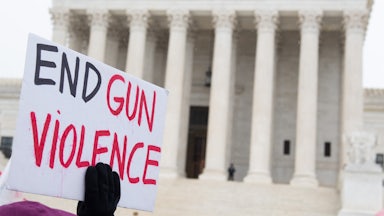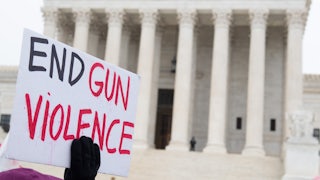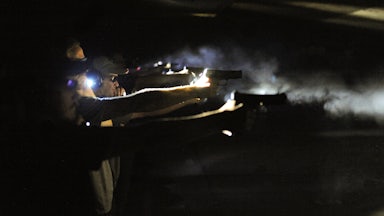Tuesday’s tragic massacre at a Texas elementary school brought gun control back to the forefront of American politics. It also drew renewed attention to a Supreme Court case where the justices will likely chart the first major expansion of the Second Amendment’s protections in more than a decade. How the court decides that case could upend whatever steps lawmakers take to address this tragedy—and the broader crisis of gun violence that it represents.
The case, New York State Rifle and Pistol Association v. Bruen, involves a legal challenge to New York’s method for distributing concealed carry permits. The challengers in the case argued that the state’s restrictive permit system violates what they describe as their constitutional right to carry a firearm outside their homes for self-defense. The state of New York told the justices that its law follows a well-established tradition for states to restrict the possession of firearms in public settings.
How the court decides Bruen could have major implications beyond New York. It will be the court’s first chance to define the scope of the Second Amendment since its rulings in D.C. v. Heller in 2008 and McDonald v. Chicago in 2010. In those two decisions, the Supreme Court first held that the Second Amendment protects an individual’s right to bear arms in Heller, then applied that ruling to state and local governments in McDonald. These decisions were both major victories for the gun rights movement.
Since then, however, the Supreme Court has been unusually quiet on what exactly that individual right to bear arms looks like. Antonin Scalia, writing for the majority in Heller, suggested that many existing regulations might still be constitutional under the new precedent. “Nothing in our opinion should be taken to cast doubt on longstanding prohibitions on the possession of firearms by felons and the mentally ill, or laws forbidding the carrying of firearms in sensitive places such as schools and government buildings, or laws imposing conditions and qualifications on the commercial sale of arms,” he explained.
Lower courts have generally used Scalia’s caveat to justify upholding most of the preexisting state and federal regulations on gun ownership, possession, and usage. Adding to the frustration of gun rights activists was a nearly decade-long silence from the Supreme Court on the Second Amendment after McDonald. Time and time again, challenges that were brought to the justices on measures ranging from assault-weapon bans to concealed carry restrictions were turned away by the court without explanation. Justice Clarence Thomas wrote in one dissent from a decision not to take up a case that he feared the Second Amendment was becoming a “second-class right.”
It only takes four votes for the Supreme Court to take up a case, leading observers like myself to surmise that some of the conservative justices—perhaps Anthony Kennedy or Chief Justice John Roberts—were hesitant to go beyond Heller. Changes in the court’s membership during the Trump presidency seem to have broken that logjam. In 2019, the court took up a highly anticipated challenge to a strict New York City gun ordinance, only to dismiss the case the following year after the state Legislature overrode the city’s ability to enact it. Gun control advocates took the unusual step to forestall what they feared might be a broad ruling from the Supreme Court when striking it down.
In Bruen, the justices will tackle New York’s system for approving concealed carry permits. The law’s critics in the gun rights movement argued that the statute’s vague language, which leaves enforcement to local sheriff’s offices, is often used to deny legitimate applications on spurious or insurmountable grounds. “The Second Amendment makes the right to carry arms for self-defense the rule, not the exception, and fundamental rights cannot be left to the whim of local government officials,” the plaintiffs said in their brief for the court. A coalition of public defenders wrote an unusual friend-of-the-court brief that claimed that the law’s arbitrary nature had resulted in severe racial disparities, and that New York had passed it to effectively “criminalize gun ownership by racial and ethnic minorities” in violation of the Second Amendment.
The state, for its part, cited a long history of restrictions on the public possession of firearms to show that its current regime falls within what eighteenth-century and nineteenth-century Americans understood to be limits on the right to bear arms. “History shows that local officials have long had wide latitude to decide where and under what circumstances firearms could be carried in public, and to restrict the carrying of concealable firearms, particularly in populous areas,” New York argued in its brief for the court. “[The plaintiffs] do not dispute that public-carry laws have continuously been in place throughout the Anglo-American world for more than seven hundred years.”
Heller, the 2008 case, only addressed a local ordinance that restricted a person’s right to own a gun within their own home. At oral arguments, the court’s conservative majority appeared ready to strike down the New York statute and expand Heller’s reasoning outside the home. Just how far the justices will go, however, remains to be seen. Some of the conservative justices, including Roberts and Justice Amy Coney Barrett, asked the parties about potential limits on carrying guns in “sensitive locations” like college campuses or public transit systems.
Only three of the justices in the Heller and McDonald majorities are still on the court today; Justices Barrett, Neil Gorsuch, and Brett Kavanaugh have not yet had the opportunity to articulate their views on the scope of the Second Amendment’s protections since their confirmations. While it’s unlikely that the New York law survives its encounter with the Supreme Court, the justices could craft a narrow ruling that strikes down the statute in question for its own peculiarities, leaving other restrictions on concealed carry permits for a future case.
Alternatively, the justices could write their ruling in Bruen in broad terms that would call restrictions in other states into question as well. While New York is an outlier when it comes to denying concealed carry permits, roughly half of the states require some sort of application process and permit to lawfully carry a concealed firearm in public. Whatever outcome the justices decide upon could have major implications for the prevalence of guns in public spaces. After Tuesday’s tragedy in Uvalde, that decision will almost certainly carry an additional emotional weight for a country that once again tries to figure out how it could—and whether it even can—prevent similar tragedies in the future.










